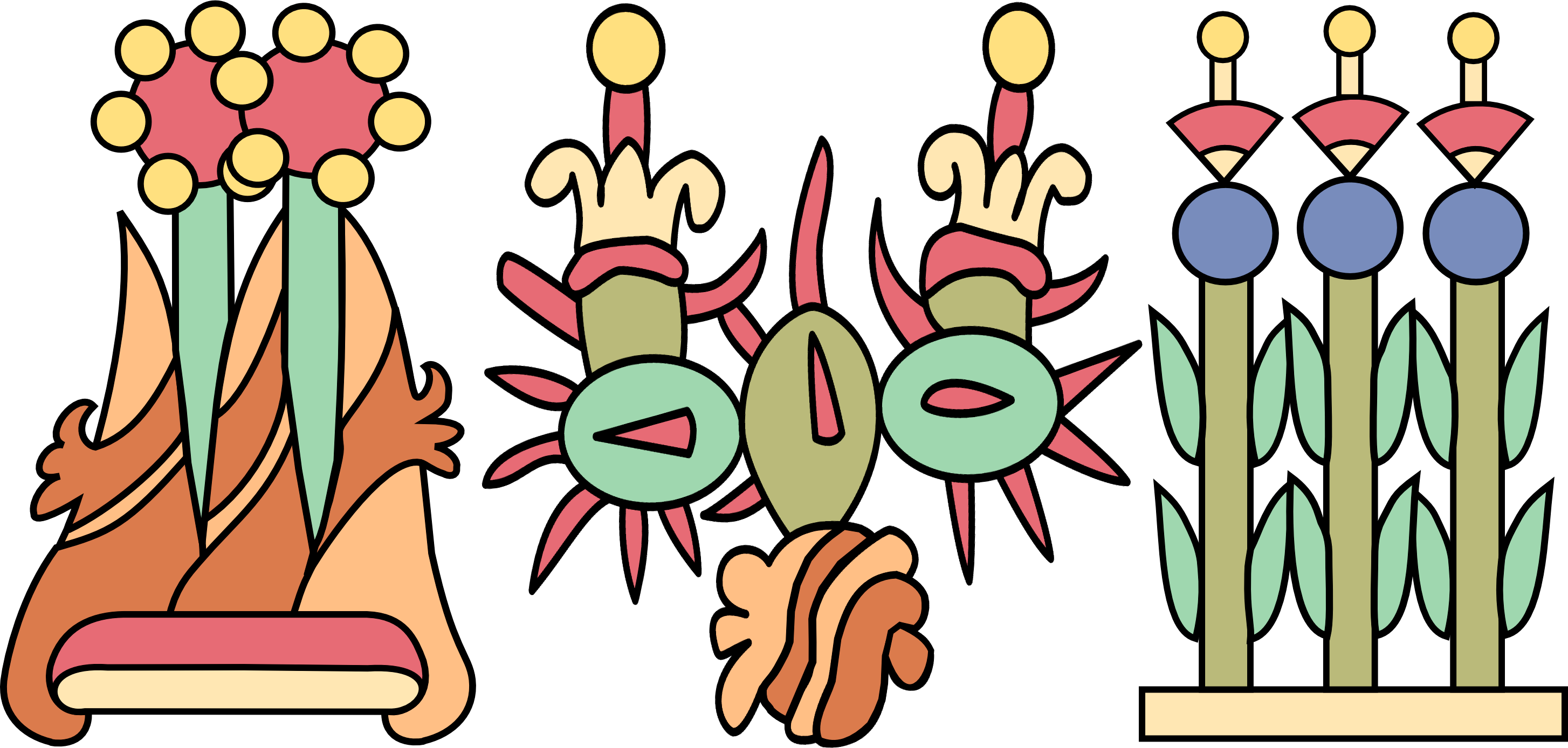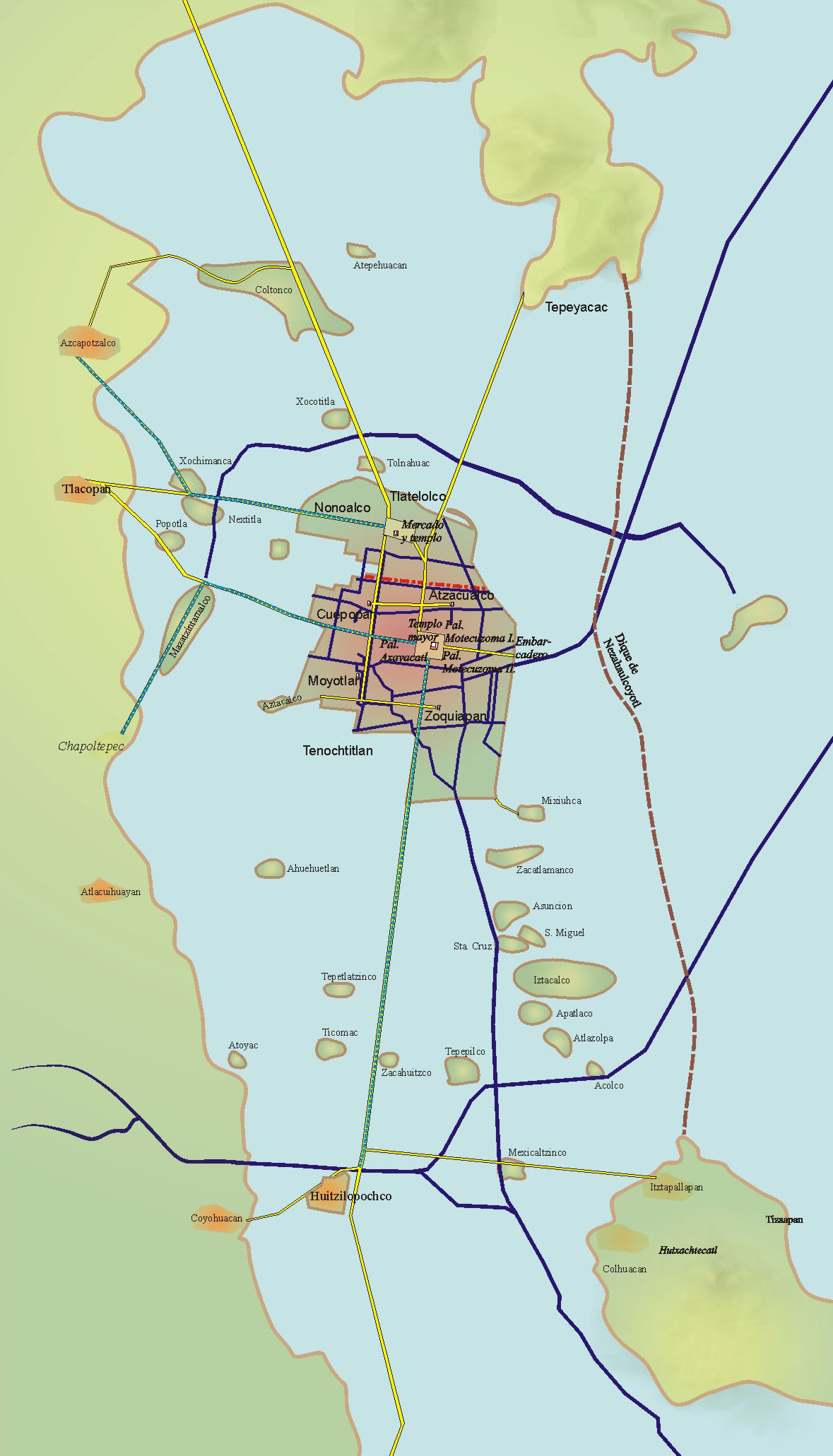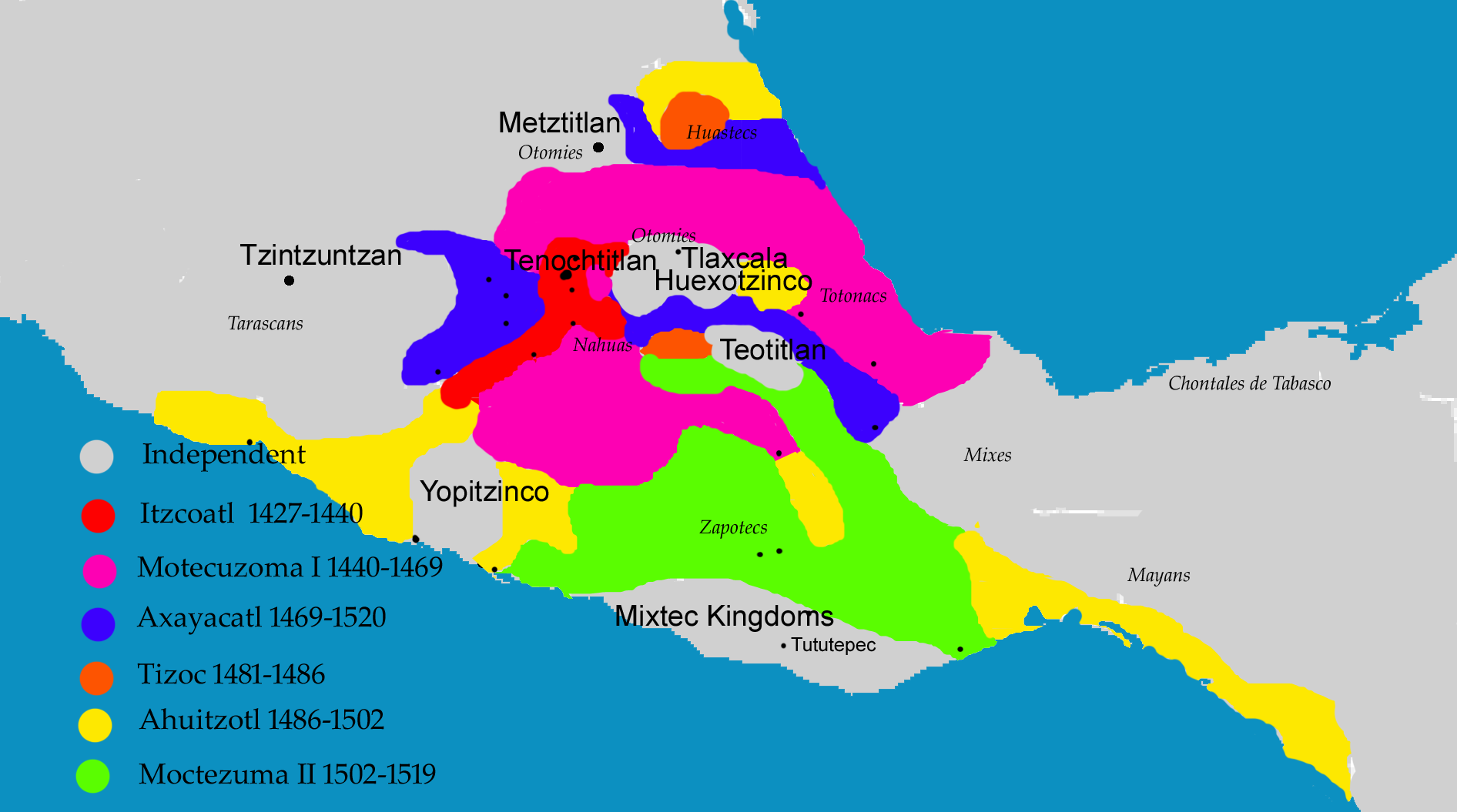|
Itzquauhtzin
Itzquauhtzin ( 9 Reed (1475)Chimalpahin (1997): pp. 140–141. – 2 Flint (1520)Chimalpahin (1997): pp. 158–159.) was a king (''tlatoani'') of Nahua ''altepetl'' Tlatelolco. He was mentioned in '' Chimalpahin Codex''. Biography Itzquauhtzin was a son of the king Tlacateotl and his aunt Xiuhcanahualtzin and grandson of Quaquapitzahuac and queen Acxocueitl. His brother was king Tezozomoctli. He was a '' quauhtlatoani'' (interim ruler). He was installed by Emperor Axayacatl of Tenochtitlan and killed by the Spaniards Spaniards, or Spanish people, are a Romance-speaking ethnic group native to the Iberian Peninsula, primarily associated with the modern nation-state of Spain. Genetically and ethnolinguistically, Spaniards belong to the broader Southern a ....Chimalpahin (1997): pp. 158–159 His successor was Diego de Mendoza. Notes {{reflist Tlatoque of Tlatelolco ... [...More Info...] [...Related Items...] OR: [Wikipedia] [Google] [Baidu] |
Tlacateotl
Tlacateotl (or Tlacateotzin; ? – 1426 or 1427/28) was the second Tlatoani of the Aztec city of Tlatelolco from 1417 until his death. Reign Under his rule the Tlatelolcas continued to expand their wealth and influence within the valley of Mexico. Through trade and tribute, the city's market grew to include trade in wool, jade and quetzal feathers. Tlacateotl also ordered the removal of sculptures from the ruins of Tula to decorate the growing city. His reign ended in 1426 or 1427/8 during the succession struggle in Azcapotzalco between Tayatzin and Maxtla. He is recorded as having been stoned to death while traveling by canoe. Maxtla is commonly assumed to have ordered the murder, possibly due to a suspected affair between Tlacateotl and Maxtla's wife. He was succeeded by his grandson, Quauhtlatoa. Family He succeeded his father, Quaquapitzahuac, upon his death in 1417. He was a brother of the queens Matlalatzin and Huacaltzintli and grandson of the famous king Tezozomoc. ... [...More Info...] [...Related Items...] OR: [Wikipedia] [Google] [Baidu] |
Tlatelolco (altepetl)
Tlatelolco ( , ) (also called Mexico Tlatelolco) was a pre-Columbian altepetl, or city-state, in the Valley of Mexico. Its inhabitants, known as the ''Tlatelolca'', were part of the Mexica, a Nahuatl-speaking people who arrived in what is now central Mexico in the 13th century. The Mexica settled on an island in Lake Texcoco and founded the ''altepetl'' of Tenochtitlan, Mexico-Tenochtitlan on the southern portion of the island. In 1337, a group of dissident Mexica broke away from the Tenochca leadership in Tenochtitlan and founded Mexico-Tlatelolco on the northern portion of the island. Tenochtitlan was closely tied with its sister city, which was largely dependent on the market of Tlatelolco, the most important site of commerce in the area. History In 1337, thirteen years after the foundation of Tenochtitlan, the Tlatelolca declared themselves independent from the Tenochca and inaugurated their first independent ''tlatoani'' (dynastic ruler). Under the king Quaquapitzahuac (1 ... [...More Info...] [...Related Items...] OR: [Wikipedia] [Google] [Baidu] |
Xiuhcanahualtzin
Xiuhcanahualtzin was a Princess of Azcapotzalco and Queen regent, Queen of Tlatelolco (altepetl), Tlatelolco by marriage. Family She was a daughter of the king Tezozomoc (Azcapotzalco), Tezozomoc and Tzihuacxochitzin and sister of the king Quaquapitzahuac. She married her nephew Tlacateotl, who was a successor of his father Quaquapitzahuac as the king of Tlatelolco. They had three children; one of them was Itzquauhtzin."And Xiuhcanahualtzin took Tlacateotzin, ruler of Tlatelolco; it was just her nephew that she married." She was also a sister of the king Maxtla. References {{reflist Nahua nobility Indigenous Mexican women ... [...More Info...] [...Related Items...] OR: [Wikipedia] [Google] [Baidu] |
Quauhtlatoani
''Cuāuhtlahtoāni'' or ''Cuäuhtlahtoh'' is a titular office of governorship and political administration, used within certain city-states and provinces among the Aztecs of pre-Columbian central Mexico in the Late Postclassic period. The office of ''cuauhtlatoani'' (a Nahuatl word meaning approximately, "the one who speaks like eagle") carried the connotation of "military ruler" or "appointed administrator". During the rise of the Aztec Empire the title was given by the ruling Mexica- Tenochca to the governors they imposed on conquered city-states in central provinces. A Tlatoani ("the one who speaks") was an independent ruler of an Aztec/Mexica polity (altepetl). Cuauhtlatoani were appointed by a Tlatoani to rule conquered areas or areas whose independence was lost such as the city Tlatelolco following the 1473 CE defeat of its last Tlatoani, Moquihuix, by Tenochtitlan. Tlatelolco was governed by Cuauhtlatoque until the death of Itzquauhtzin in 1520 CE. The title is also used i ... [...More Info...] [...Related Items...] OR: [Wikipedia] [Google] [Baidu] |
Spaniards
Spaniards, or Spanish people, are a Romance-speaking ethnic group native to the Iberian Peninsula, primarily associated with the modern nation-state of Spain. Genetically and ethnolinguistically, Spaniards belong to the broader Southern and Western European populations, exhibiting a high degree of continuity with other Indo-European-derived ethnic groups in the region. Spain is also home to a diverse array of national and regional identities, shaped by its complex history. These include various languages and dialects, many of which are direct descendants of Latin, the language imposed during Roman rule. Among them, Spanish (also known as Castilian) is the most widely spoken and the only official language across the entire country. Commonly spoken regional languages include, most notably, the sole surviving indigenous language of Iberia, Basque, as well as other Latin-descended Romance languages like Spanish itself, Catalan and Galician. Many populations outside Sp ... [...More Info...] [...Related Items...] OR: [Wikipedia] [Google] [Baidu] |
Tenochtitlan
, also known as Mexico-Tenochtitlan, was a large Mexican in what is now the historic center of Mexico City. The exact date of the founding of the city is unclear, but the date 13 March 1325 was chosen in 1925 to celebrate the 600th anniversary of the city. The city was built on an island in what was then Lake Texcoco in the Valley of Mexico. The city was the capital of the expanding Aztec Empire in the 15th century until it was Fall of Tenochtitlan, captured by the Tlaxcaltec and the Spanish in 1521. At its peak, it was the largest city-state, city in the pre-Columbian Americas. It subsequently became a ''Municipalities of Mexico, cabecera'' of the Viceroyalty of New Spain. Today, the ruins of are in the historic center of the Mexican capital. The World Heritage Site of contains what remains of the geography (water, boats, Chinampa, floating gardens) of the Mexica capital. was one of two Mexica (city-states or Polity, polities) on the island, the other being . Etymol ... [...More Info...] [...Related Items...] OR: [Wikipedia] [Google] [Baidu] |
Axayacatl
Axayacatl (; ; ; meaning "face of water"; –1481) was the sixth of the of Tenochtitlan and Emperor of the Aztec Triple Alliance. Biography Early life and background Axayacatl was a son of the princess Atotoztli II and her cousin, prince Tezozomoc (son of Itzcoatl), Tezozomoc. He was a grandson of the Emperors Moctezuma I and Itzcoatl. He was a descendant of the king Cuauhtototzin. He was a successor of Moctezuma and his brothers were Emperors Tizoc and Ahuitzotl and his sister was the Queen Chalchiuhnenetzin. He was an uncle of the Emperor Cuauhtémoc and father of Emperors Moctezuma II and Cuitláhuac. Rise to power During his youth, his military prowess gained him the favor influential figures such as Nezahualcoyotl (tlatoani), Nezahualcoyotl and Tlacaelel I, and thus, upon the death of Moctezuma I in 1469, he was chosen to ascend to the throne, much to the displeasure of his two older brothers, Tizoc and Ahuitzotl. It is also important that the Aztec calendar stone, ... [...More Info...] [...Related Items...] OR: [Wikipedia] [Google] [Baidu] |
Tezozomoctli (Cuauhtitlan)
Tezozomoctli (originally Teçoçomoctli; ruled 1418Bierhorst (1992): pp. 80–81.–1430Bierhorst (1992): pp. 90–93.) was a ''tlatoani'' ("ruler" or "king") of the pre-Columbian Nahua ''altepetl'' (city-state) of Cuauhtitlan in central Mexico. His palace was located at Huexocalco. Tezozomoctli was born in the Mexica city of Tlatelolco. His father was Tlacateotl, who was the second tlatoani of Tlatelolco. His mother was Xiuhtomiyauhtzin, the daughter of the tlatoani of Coatl Ichan, Acolmiztli.Chimalpahin (1997): vol. 2, p. 113. Tezozomoctli was probably named after his great-grandfather, the powerful ruler of Azcapotzalco. In the Tepanec War in the year 3 Rabbit (1430), Cuauhtitlan was attacked and defeated by the combined forces of the surrounding peoples. After being informed at his refuge at Cincoc Huehuetocan that Cuauhtitlan had been captured, Tezozomoctli travelled to Atzompan where he allegedly committed suicide by poison A poison is any chemical substanc ... [...More Info...] [...Related Items...] OR: [Wikipedia] [Google] [Baidu] |
Acxocueitl
Acxocueitl was the first Queen consort of city-state of Tlatelolco. She was a daughter of Acolmiztli and the princess, Tlazozomizqui.''Anales de Tlatelolco'' She married Quaquapitzahuac. Their children were: *Tlacateotl *Matlalatzin *Huacaltzintli Huacaltzintli was a Princess of Tlatelolco and Queen of Tenochtitlan. She was a daughter of the king Quaquapitzahuac and sister of the king Tlacateotl and queen Matlalatzin. Her husband was Itzcoatl, Aztec emperor. She gave birth to a son, who sh ... She was a grandmother of the prince Tezozomoc and sister of Xiuhtomiyauhtzin. References {{Reflist Nahua nobility Indigenous Mexican women ... [...More Info...] [...Related Items...] OR: [Wikipedia] [Google] [Baidu] |
Quaquapitzahuac
Quaquapitzahuac (died 1417) was the first ruler of the Aztec city of Tlatelolco (altepetl), Tlatelolco. His name, which means "Slender Horn", was pronounced in Classical Nahuatl, and is also spelled Cuacuauhpitzahuac, Cuacuapitzahuac, and Quaquauhpitzahuac. His nephew was Tecollotzin. Reign Quaquapitzahuac was appointed by his father, Tezozomoc (Azcapotzalco), Tezozomoc, in 1376 to serve as the first tlatoani of Tlatelolco, thus beginning that city's royal house. Under his rule, Tlatelolcan armies participated in various conquests on behalf of the city of Azcapotzalco (altepetl), Azcapotzalco, winning the right to receive tribute from the conquered towns in the east of the valley of Mexico. Family He was a son of famous Tezozomoc (Azcapotzalco), Tezozomoc, the Tepanec ruler of Azcapotzalco. He was a brother of the kings Aculnahuacatl Tzaqualcatl, Tzihuactlayahuallohuatzin, Maxtla, Epcoatl and the queen Ayauhcihuatl. His wife was called Acxocueitl. Upon his death in 1417, he ... [...More Info...] [...Related Items...] OR: [Wikipedia] [Google] [Baidu] |
Moctezuma And Itzquauhtzin
Montezuma or Moctezuma may refer to: People * Moctezuma I (1398–1469), the second Aztec emperor and fifth king of Tenochtitlan * Moctezuma II (c. 1460–1520), ninth Aztec emperor ** Pedro Moctezuma, a son of Montezuma II ** Isabel Moctezuma (1509/1510–1550/1551), a daughter of Montezuma II *** Leonor Cortés Moctezuma (c. 1528–?), daughter of Hernán Cortés and Isabel Montezuma **** Isabel de Tolosa Cortés de Moctezuma (1568–1619/1620), Mexican heiress, great-granddaughter of Montezuma II * Duke of Moctezuma de Tultengo, a Spanish hereditary title held by descendants of Moctezuma II * Carlos Montezuma (c. 1860–1923), Yavapai/Apache Native American activist * Carlos López Moctezuma (1909–1980), Mexican film actor * Eduardo Matos Moctezuma (born 1940), Mexican archaeologist * Esteban Moctezuma (born 1954), Mexican politician * Julio Rodolfo Moctezuma (1927–2000), Mexican lawyer, politician and banker * Leonidas de Montezuma (1869–1937), English cricketer * M ... [...More Info...] [...Related Items...] OR: [Wikipedia] [Google] [Baidu] |
Aztec Calendar
The Aztec or Mexica calendar is the calendar, calendrical system used by the Aztecs as well as other Pre-Columbian era, Pre-Columbian indigenous peoples of Mexico, peoples of central Mexico. It is one of the Mesoamerican calendars, sharing the basic structure of calendars from throughout the region. The Aztec sun stone, often erroneously called the calendar stone, is on display at the National Museum of Anthropology (Mexico), National Museum of Anthropology in Mexico City. The actual Aztec calendar consists of a 365-day calendar cycle called (year count), and a 260-day ritual cycle called (day count). These two cycles together form a 52-year "century", sometimes called the "Calendar Round, calendar round". The is considered to be the agricultural calendar, since it is based on the sun, and the is considered to be the sacred calendar. Tōnalpōhualli The ("day count") consists of a cycle of 260 days, each day signified by a combination of a number from 1 to 13, and one of th ... [...More Info...] [...Related Items...] OR: [Wikipedia] [Google] [Baidu] |




